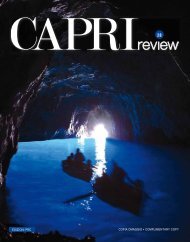Create successful ePaper yourself
Turn your PDF publications into a flip-book with our unique Google optimized e-Paper software.
etimo che probabilmente deriva<br />
questa volta dal latino asper (roccia<br />
dura), modificato nel corso dei secoli<br />
da misteriose contorsioni fo<strong>net</strong>iche<br />
e anagrammatiche, in <strong>Capri</strong>, così<br />
come credeva anche Norman Douglas.<br />
Altri, con minore fantasia ma<br />
più assonanza, affermano che a <strong>Capri</strong><br />
vi è stato un re che si chiamava<br />
Capreus.<br />
Di certo a questi zooetimi avremmo<br />
preferito quello più poetico di Omero<br />
che denominò <strong>Capri</strong> “isola delle<br />
Sirene” in cui essendovi un prato,<br />
detto Antemusso, l’isola venne an-<br />
che detta Antemussa dal poeta<br />
Apollonio nella bella descrizione del<br />
viaggio dei suoi argonauti nel Cratere<br />
partenopeo.<br />
Comunque, per la gran parte dei filologi<br />
contemporanei e moderni <strong>Capri</strong><br />
è “l’isola delle capre”. Ma di<br />
quale capra? Ovviamente della capra<br />
selvatica, capra aegagrus della<br />
cui pelle era coperto lo scudo di<br />
Giove Egioco.<br />
Forse sarebbe stato preferibile che a<br />
rappresentare l’isola fosse stato un<br />
robusto muflone o un elegante stambeco,<br />
se non iberico almeno alpi-<br />
CORBIS - CONTRASTO<br />
▼<br />
WHY CAPRI?<br />
by CIRO SANDOMENICO<br />
Fascinating facts, fantasies<br />
and fables about the origin<br />
of the island’s name<br />
Associating this enchanting blue island<br />
with a bovine artiodactyl like the goat is<br />
perhaps not acceptable for those who<br />
love <strong>Capri</strong>, drawn and mesmerized by its<br />
natural beauty, its colours, the sensual shape<br />
of its coastline, the many echoes of its<br />
fascinating history, and so much more.<br />
That this marvellous island should have taken<br />
its name from the “bony and wiry” goat or<br />
capra, an animal with “unbridled, voracious<br />
sensuality and ancestral, insatiable hunger”–<br />
to borrow some expressions from historian<br />
Giuseppe Galasso – is too much at odds with<br />
the concepts of beauty, refinement and<br />
elegance that <strong>Capri</strong> evokes.<br />
Some people may remark that many other<br />
islands and headlands also draw their names<br />
from similar zoological etymology. Caprara,<br />
Capraia, Caprera are just some of the names<br />
linked to the word <strong>Capri</strong>. But delving into the<br />
mysterious, obscure depths of etymological<br />
and pho<strong>net</strong>ic research, even islands that at first<br />
seem to have more attractive and gentle<br />
names may have some surprises in store. For<br />
example, the Isola del Giglio (Island of the Lily)<br />
which, if you look closer, is also associated<br />
with goats. In antiquity, its name was Igilum,<br />
deriving from the Greek Aigílion or Aigilia,<br />
whose root aig- means “goat”, at least<br />
according to the etymological routes suggested<br />
by Domenico Silvestri in the erudite volume<br />
<strong>Capri</strong> antica, published by La Conchiglia.<br />
But one great authority on <strong>Capri</strong> maintains<br />
that the name means “island of sharp stones”<br />
and, to be quite honest, we prefer this version,<br />
though the writer fails to provide any further<br />
explanation for this, which probably derives<br />
from the Latin asper (hard rock), corrupted<br />
over the centuries by mysterious pho<strong>net</strong>ic and<br />
ungrammatical misuses until it became<br />
“<strong>Capri</strong>”, as Norman Douglas also believed.<br />
Others, who are less imaginative and are<br />
swayed by assonance, consider that <strong>Capri</strong><br />
comes from the fact that it was once home to<br />
a king called Capreus.<br />
Certainly, rather than these zoological<br />
associations, we would have preferred the<br />
more poetic version of Homer, for whom <strong>Capri</strong><br />
was the island of the Sirens. Due to one of the<br />
meadows there, known as Antemusso, the<br />
island was also dubbed Antemussa by the<br />
poet Apollonius, in his fine description of the<br />
voyage of his Argonauts into the<br />
Parthenopean crater.<br />
However, for most modern and contemporary<br />
philologists, the name <strong>Capri</strong> is linked to<br />
the goat. But which goat? Obviously the<br />
▼<br />
31







